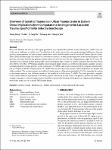Item Infomation
Full metadata record
| DC Field | Value | Language |
|---|---|---|
| dc.contributor.author | Sheng, Dong | - |
| dc.contributor.author | Tie, Wu | - |
| dc.contributor.author | Yi-Feng, Wu | - |
| dc.date.accessioned | 2023-04-19T04:25:07Z | - |
| dc.date.available | 2023-04-19T04:25:07Z | - |
| dc.date.issued | 2023 | - |
| dc.identifier.uri | https://link.springer.com/article/10.1007/s44196-023-00247-0 | - |
| dc.identifier.uri | https://dlib.phenikaa-uni.edu.vn/handle/PNK/8067 | - |
| dc.description | CC BY | vi |
| dc.description.abstract | Due to the lifestyle and activity of the aging population, it is expected that geriatric trauma will increase and become one of the major challenges in health care. The objective of this study was to determine epidemiological differences between geriatric trauma patients and their younger counterparts, and to find the implications for localized Trauma-Specific Frailty Index (TSFI) system design. This study was a retrospective analysis of adult patients registered in the Trauma Registry, comparisons were made between the geriatric patients, aged over 65 years old, and the younger patients, aged 18–64 years old. Variables were collected include demography, injury mechanism, type, severity of injuries sustained, and outcomes. | vi |
| dc.language.iso | en | vi |
| dc.publisher | Springer | vi |
| dc.subject | TSFI | vi |
| dc.subject | Localized Trauma-Specific Frailty Index System Design | vi |
| dc.title | Overview of Geriatric Trauma in an Urban Trauma Center in Eastern China: Implications from Computational Intelligence for Localized Trauma-Specific Frailty Index System Design | vi |
| dc.type | Book | vi |
| Appears in Collections | ||
| OER - Kỹ thuật điện; Điện tử - Viễn thông | ||
Files in This Item:

